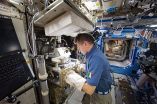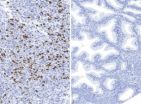CLEVELAND, OH, March 19, 2013 (Press-News.org) Be it laundry detergent, paint, ketchup or salad dressing, even before it leaves the production line, gravity begins tugging at it, trying to separate the mixture into different parts. As products separate, they can become watery or gooey. To combat product collapse and increase shelf life, manufactures use stabilizers.
The Advanced Colloids Experiment (ACE-M-1) is designed to help researchers understand how to optimize stabilizers to extend product shelf life, while also cutting development, production and transportation costs. ACE-M-1 launched to the International Space Station on the second commercial resupply flight of the SpaceX Dragon on March 1.
"When these products sit on a shelf for a certain amount of time, they start coarsening and separating," said Bill Meyer, ACE-M-1 project scientist at NASA's Glenn Research Center in Cleveland. "You see a top half and a bottom half that are different. Stabilizers keep the product doing what you want it to do. While we have a general understanding about what is happening at the particle level with these stabilizers, there's a lot more that we need to know."
On Earth, several things happen simultaneously. For example, depending on the mixture, particles move around and settle at the same time. As they coarsen or evolve and change, heavier particles can settle to the bottom within only a few minutes -- a process called sedimentation. Such complexity makes it hard to observe the underlying physics. Microgravity allows scientist to create models and develop more universal theories by essentially slowing down the separation process.
"We can do things in space we can't do on Earth," Meyer said. "Gravity masks the effect we're looking for. In space you won't see a top and bottom half since that's caused by gravity and density differences. What you'll see on the International Space Station is little blobs form. And those little blobs will grow over time. In microgravity we can measure this coarsening, or evolution, since gravity's influence is about a million times weaker."
Matthew Lynch, ACE-M-1, principal investigator and principal scientist at Procter & Gamble (P&G) in Cincinnati, describes it as a house-of-cards. Solid particles organize into a network that supports weight and counteracts the tendency separate.
"If you remove too many cards, the structure collapses," Lynch said. "Coarsening is about the rate at which the cards move around. There are some rudimentary theories that allow us to treat such time scales where all the cards are the same. However, we can't anticipate the fall of the house-of-cards when the cards are very different. Further, we do not have a framework to understand the movement altogether. For example, do we pull cards out of the house altogether and place them on top, or do we shuffle them around other cards in the same locale."
P&G, an international producer of scores of consumer products, is using the ACE-M-1 investigation to study product stability on the space station. P&G products like liquid detergent, shampoos, cleaners and medicine are colloidal systems. Anything that has particles of one micron or less in suspension is known as a colloid system. To give an idea of the size of a colloid, a very fine human hair is about 100 microns in diameter.
In colloidal systems, heavier particles settle to the bottom while lighter ones float to the top. Colloidal gels make up the microstructure of many consumer products such as detergents and shampoos. These gels are often polydisperse, which is where little particles are not just one size but a range of sizes. To control these systems, scientists need an understanding of the coarsening of the microstructure.
"We're doing research on the International Space Station because it teaches all about our stabilizing systems and our products," said Lynch. "Stabilizers keep everything together to make sure that when somebody buys a product and uses it, it keeps all the material basically uniform throughout the product."
With the effects of gravity removed, ACE-M-1 will allow scientists to use the Light Microscopy Module (LMM) to observe what happens at the particle level. A remotely controllable, automated microscope, the LMM gives scientists the ability to study specimens in microgravity in real time while the interesting science is happening. The LMM, which operates in the Fluids & Combustion Facility (FCF), resides in the space station's Destiny Laboratory and is managed by NASA's Glenn Research Center.
The FCF is a refrigerator-size rack, about 6 feet tall. The sample module inside the rack is approximately the size of a deck of cards. The ACE-M-1 sample itself is only a couple drops, measuring a couple microliters in volume. The investigation will run several experiments throughout its months aboard the space station.
"We do several things in space," said Ron Sicker, ACE-M-1 project manager, NASA's Glenn Research Center. "Some of the things we do are theoretical. The payoff may be big, but it may be many years in the future before it is realized. The ACE-M-1 investigation we're doing with Procter and Gamble holds open both the possibility for a long-term, theoretical win, as well as a win within just a few years as it finds its way into everyday products."
Better stabilizers could stack the deck in our favor. It could mean many things for manufacturers and consumers, including better quality, reduced costs and greener, more concentrated products that use less plastic in their packaging. It could mean products that resist collapse to remain consistent throughout their life, where the first ounce coming out of the bottle is the same as the last.
For more about the International Space Station or information on past, ongoing, and future ISS research activities, including research results and publications, visit:
http://www.nasa.gov/mission_pages/station/main/index.html
If you are interested in subscribing to updates from the ISS Program Science Office, visit:
https://lists.nasa.gov/mailman/listinfo/iss-program-science-group
ACE: Stacking the Deck in Our Favor
Release: JR13-020
2013-03-19
ELSE PRESS RELEASES FROM THIS DATE:
Columbia University Medical Center/NY-Presbyterian experts at AAN
2013-03-18
The following research from Columbia University Medical Center and NewYork-Presbyterian Hospital is being presented at the 65th annual meeting of the American Academy of Neurology (AAN), March 16-23, 2013, in San Diego.
For additional information, or to arrange an interview, please contact Karin Eskenazi at 212-342-0508 or ket2116@columbia.edu, or Christina Stolfo at 212-305-5587 or chs9135@nyp.org
ORAL PRESENTATIONS
Deoxypyrimidine Monophosphates Treatment for Thymidine Kinase 2 Deficiency
Authors: Caterina Garone, Beatriz Garcia-Diaz, Valentina Emmanuele, Saba ...
PCa markers improve predictive performance of existing clinical variables
2013-03-18
Milan, 15 March 2013 – A genetic score based on PCa risk-associated single nucleotide polymorphisms (SNPs) is an independent predictor of prostate biopsy outcomes, suggest the results of a new study conducted by a group from the Department of Urology Huashan Hospital, Fudan University in Shanghai, China.
The authors, who relate their findings to the male population in China, also suggest that this score can improve predictive performance of existing clinical variables, especially for patients with a total PSA levels < 20 ng/ml
"Genetic susceptibility to prostate cancer ...
New study: Incidence and mortality of PCa after termination of PSA-based screening
2013-03-18
Milan, 15 March 2013 - Men who participate in biennial PSA based screening have a lower risk of being diagnosed as well as dying from prostate cancer up to 9 years after their last PSA test, according to the results of a new study to be presented at the 28th Annual EAU Congress in Milan
A joint Swedish-UK study aimed to examined the risk of developing prostate cancer after last invitation to screening. This investigation follows up on previous publication from the Göteborg randomized screening trial (part of ERSPC) by the same group which showed that biennial PSA screening ...
ChemCam data abundant at Planetary Conference
2013-03-18
LOS ALAMOS, N.M., March 15, 2013 — Members of the Mars Science Laboratory Curiosity rover ChemCam team will present more than two dozen posters and talks next week during the 44th Lunar and Planetary Science Conference in The Woodlands, Texas.
"ChemCam has performed flawlessly in its first six months, providing more than a gigabyte of exciting new information about the Red Planet," said Los Alamos National Laboratory planetary scientist Roger Wiens, Principal Investigator of the ChemCam Team. "Since Curiosity's successful landing on Mars on August 6, 2012, ChemCam has ...
UK study: Epigenetic changes play a key role in development of chemo resistance in BCa
2013-03-18
Milan, 16 March 2013 - At the 28th Annual EAU Congress currently ongoing in Milan until Tuesday, W. Tan and colleagues presented their study on neoadjuvant cisplatin-based chemotherapy which showed that epigenetic changes are potential key drivers in the development of chemo resistance in bladder cancer.
Neoadjuvant cisplatin-based chemotherapy is recommended for patients with muscle invasive bladder cancer. Cisplatin-based regimes have similar efficacy with complete response in 30% a survival advantage if 16% (HR, 0.84;CI 0.72 to 0.99), wrote Tan of the UCL, Dept. ...
New study points to the aggressive potential of small kidney tumors, advocates treatment
2013-03-18
Milan, 16 March 2013 – Small kidney tumours have an agressive potential and should be treated, according to a the results of a large multicentre study presented at the 28th Annual EAU Congress in Milan.
"Many clinicians regard small renal cell cancer as having a benign biologic behavior and non-operative surveillance protocols are often being used in patients with small renal tumours," write the authors in the findings. "The aim of this large retrospective multi-centre study was to evaluate the prevalence of locally advanced growth and distant metastases in patients with ...
Where, oh where, has the road kill gone?
2013-03-18
Millions of birds die in the US each year as they collide with moving vehicles, but things have been looking up, at least in the case of cliff swallows. Today's swallows are hit less often, thanks to shorter wingspans that may help them take off more quickly and pivot away from passing cars. The findings, reported in the Cell Press journal Current Biology on March 18, show that urban environments can be evolutionary hotspots.
"Evolution is an ongoing process, and all this—roads, SUVs, and all—is part of nature or 'the wild'; they exert selection pressures in a way we ...
Putting the clock in 'cock-a-doodle-doo'
2013-03-18
Of course, roosters crow with the dawn. But are they simply reacting to the environment, or do they really know what time of day it is? Researchers reporting on March 18 in Current Biology, a Cell Press publication, have evidence that puts the clock in "cock-a-doodle-doo" (or "ko-ke-kok-koh," as they say in the research team's native Japan).
"'Cock-a-doodle-doo' symbolizes the break of dawn in many countries," says Takashi Yoshimura of Nagoya University. "But it wasn't clear whether crowing is under the control of a biological clock or is simply a response to external ...
How some prostate tumors resist treatment -- and how it might be fixed
2013-03-18
LA JOLLA, Calif., March 18, 2013 – Hormonal therapies can help control advanced prostate cancer for a time. However, for most men, at some point their prostate cancer eventually stops responding to further hormonal treatment. This stage of the disease is called androgen-insensitive or castration-resistant prostate cancer. In a study published March 18 in Cancer Cell, a team led by researchers at Sanford-Burnham Medical Research Institute (Sanford-Burnham) found a mechanism at play in androgen-insensitive cells that enables them to survive treatment. They discovered that ...
Oral estrogen hormone therapy linked to increased risk of gallbladder surgery in menopausal women
2013-03-18
Oral estrogen therapy for menopausal women is associated with an increased risk of gallbladder surgery, according to a large-scale study of more than 70 000 women in France published in CMAJ (Canadian Medical Association Journal)
Women who took estrogen therapy through skin patches or gels did not appear to be at increased risk.
Gallstone disease is common in developed countries, and women over age 50 are most at risk. Other risk factors include obesity, diabetes, high cholesterol, poor diet and having given birth to two or more children.
A large study of 70 928 ...
LAST 30 PRESS RELEASES:
The impact of family dynamics on eating behaviour – how going home for Christmas can change how you eat
Tracing the quick synthesis of an industrially important catalyst
New software sheds light on cancer’s hidden genetic networks
UT Health San Antonio awarded $3 million in CPRIT grants to bolster cancer research and prevention efforts in South Texas
Third symposium spotlights global challenge of new contaminants in China’s fight against pollution
From straw to soil harmony: International team reveals how biochar supercharges carbon-smart farming
Myeloma: How AI is redrawing the map of cancer care
Manhattan E. Charurat, Ph.D., MHS invested as the Homer and Martha Gudelsky Distinguished Professor in Medicine at the University of Maryland School of Medicine
Insilico Medicine’s Pharma.AI Q4 Winter Launch Recap: Revolutionizing drug discovery with cutting-edge AI innovations, accelerating the path to pharmaceutical superintelligence
Nanoplastics have diet-dependent impacts on digestive system health
Brain neuron death occurs throughout life and increases with age, a natural human protein drug may halt neuron death in Alzheimer’s disease
SPIE and CLP announce the recipients of the 2025 Advanced Photonics Young Innovator Award
Lessons from the Caldor Fire’s Christmas Valley ‘Miracle’
Ant societies rose by trading individual protection for collective power
Research reveals how ancient viral DNA shapes early embryonic development
A molecular gatekeeper that controls protein synthesis
New ‘cloaking device’ concept to shield sensitive tech from magnetic fields
Researchers show impact of mountain building and climate change on alpine biodiversity
Study models the transition from Neanderthals to modern humans in Europe
University of Phoenix College of Doctoral Studies releases white paper on AI-driven skilling to reduce burnout and restore worker autonomy
AIs fail at the game of visual “telephone”
The levers for a sustainable food system
Potential changes in US homelessness by ending federal support for housing first programs
Vulnerability of large language models to prompt injection when providing medical advice
Researchers develop new system for high-energy-density, long-life, multi-electron transfer bromine-based flow batteries
Ending federal support for housing first programs could increase U.S. homelessness by 5% in one year, new JAMA study finds
New research uncovers molecular ‘safety switch’ shielding cancers from immune attack
Bacteria resisting viral infection can still sink carbon to ocean floor
Younger biological age may increase depression risk in older women during COVID-19
Bharat Innovates 2026 National Basecamp Showcases India’s Most Promising Deep-Tech Ventures
[Press-News.org] ACE: Stacking the Deck in Our FavorRelease: JR13-020




